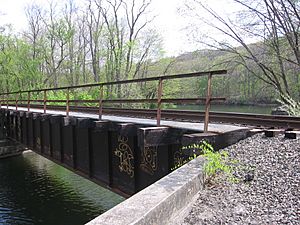Still River (Housatonic River tributary) facts for kids

The Still River is a river in western Connecticut that flows into the Housatonic River. It is about 25.4 miles (40.9 km) long.
Contents
Where the Still River Flows
The Still River starts from Farrington's Pond near the New York border with Danbury, Connecticut. It then flows through Sanfords Pond and Lake Kenosia. After that, it goes into a concrete tunnel near downtown Danbury. The river then turns north, flowing through Brookfield and southern New Milford. Finally, it joins the Housatonic River. The area of land that drains water into the Still River is about 85 square miles.
The Still River has an interesting history that has shaped its condition today. For a long time, the river faced serious pollution. This pollution came from farming and, later, from the hat-making industry. These problems caused harm to the environment and the river's living things. Because of this, people realized the river needed a lot of help and cleanup.
A River's Story: From Pollution to Progress
Even before hat-making began in the late 1700s, the Still River was known as a "dead river." This was because farms around Danbury, Connecticut, used the river to get rid of waste. Historical records from the 1880s show that the river was used like a sewage dump. Its water became unusable for farming and factories.
Things started to change after a court ruling in 1895. Later, the Clean Water Act in 1972 made the city of Danbury responsible for the river's condition. In 1993, Danbury built a new sewage treatment plant. This plant helped to make the water much cleaner. In 2014, a group called the Still River Partners was formed. This group works to improve the river and its surrounding land, and they are still working on it today.
Pollution's Impact on the Still River
From around 1860 through the early 1900s, hat factories released a chemical called mercury nitrate into the river. These factories used this chemical to help make felt from animal fur. During this time, the amount of mercury in the river was extremely high. It was about 500 times higher than normal levels.
While hat factories were the main source of mercury pollution, other industries also added to the problem. For example, the P. Robinson Fur Cutting Company, which removed fur, was also located on the Still River.
When the hat industry was at its busiest, the mercury pollution traveled down the Still River. It then flowed into the Housatonic River and even reached the Long Island Sound.
The mercury pollution was very harmful to the river's plants and animals. The river's health did not truly start to get better until the new sewage treatment plant was built. Today, many types of fish can be found in the river again. There are even places to launch kayaks downstream from Danbury.
Working Together for a Cleaner River
Several groups are working hard to protect the Still River and the land around it. In 1995, the Still River Alliance was created. This group worked to improve the river's health.
More recently, the Still River Partners group was formed. This group is led by the Housatonic Valley Association and gets money from the Connecticut Department of Energy and Environmental Protection. They bring together important local groups and towns. The Still River Partners have an approved plan to improve the water quality of the Still River, and they are still actively working on this important project today.

